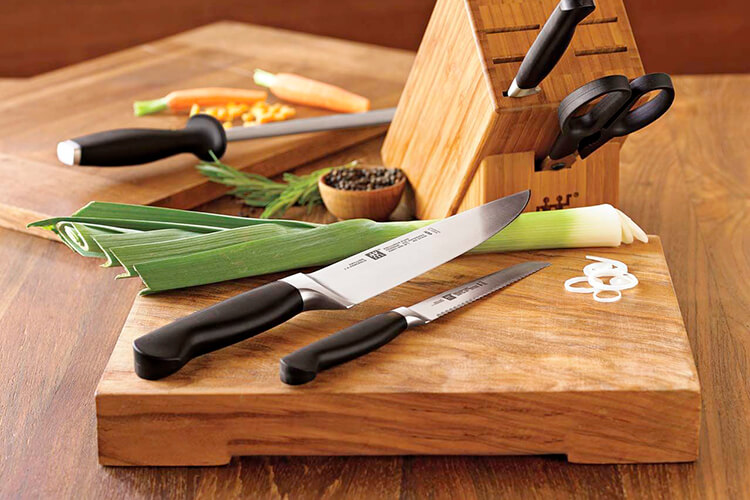TOP 10 best steel grades for knives: rating 2024-2025 and which one is better to choose
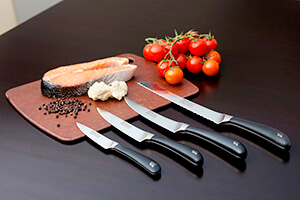 Cutting and chopping food, going for mushrooms, a simple picnic is not complete without a good knife. A housewife, a huntsman, and even a diver will be happy with a durable and reliable blade.
Cutting and chopping food, going for mushrooms, a simple picnic is not complete without a good knife. A housewife, a huntsman, and even a diver will be happy with a durable and reliable blade.
But how to choose the right blade? It is worth paying attention to steel and its properties - all the main indicators of a knife depend on the metal.
In our article, we have selected the best steels for the production of knives. We took into account alloy compositions, expert opinions, reviews of specialists and ordinary customers, as well as statistical data on the use of various steel grades in the production of modern knives, including premium branded ones.
Rating of the TOP 10 best steel grades for knives for 2024-2025
This ranking table contains the best steel grades according to experts and users.
| Place | Name | Price |
|---|---|---|
| TOP 10 best steel grades for knives by price/quality for 2024-2025 | ||
| 1 | D2 | |
| 2 | Sandvik 12C27 | |
| 3 | M390 | |
| 4 | Elmax | |
| 5 | 440C | |
| 6 | VG-10 | Ask for a price |
| 7 | CPM-S30V | |
| 8 | AUS-8A | |
| 9 | 95X18 | |
| 10 | 1.4116 | |
Content
How to choose a steel grade and what to look for?
In many ways, the mechanical properties of steel depend on alloying additives - vanadium, cobalt, tungsten. Even at minimum levels, they significantly increase the quality of the blades.
Therefore, the first thing you should pay attention to is the composition:
- carbon - increases the hardness and strength of steel, increases the resistance of the blade to wear and the appearance of chips and cracks, but a large amount in the composition significantly reduces the overall corrosion resistance;
- chromium - increases the hardness, density of the blades, is responsible for the resistance to corrosion and the possibility of polishing the blade.Found in all modern stainless steels. In addition, the chromium content gives the blades a characteristic polishing sheen, adding an aesthetic component to them;
- manganese - increases the toughness and hardenability of steel, increases resistance to lateral deformation, but its high content in steel makes it brittle. Rails and safes are mainly made from steels with a high manganese content; manganese steel is rarely used in the manufacture of knives;
- molybdenum - an alloying element that gives the metal elasticity and density, improves hardenability and strength. This is a hard-melting element that prevents the blade from breaking, increases resistance to high temperatures, and gives the blade the necessary rigidity;
- vanadium - another alloying element that increases the viscosity and strength of the blade, improves wear resistance, and contributes to better annealing. It is mainly used for tool steels, in particular surgical ones. Makes the metal inert to aggressive chemicals;
- nickel – prevents the appearance of rust and acidification of the blade;
- silicon – increases the wear resistance of the alloy, makes it more reliable and stable;
- phosphorus - its content in steel is undesirable, it makes the metal brittle, while increasing its strength. The maximum phosphorus content must not exceed 0.045%;
- sulfur - another "harmful" element that reduces the resistance to lateral deformation, but increases the strength of the metal when exposed to the axis of the metal lattice. A high sulfur content significantly reduces the mechanical and physico-chemical properties of steel alloys: ductility, impact strength, corrosion resistance.The sulfur content in good steel should not exceed 0.06%.
You also need to pay attention to the following parameters:
- corrosion resistance - If the knife frequently comes into contact with water, blood or other liquids, anti-corrosion qualities are leading when choosing a good knife. Any liquid, especially blood, has a bad effect on the overall quality of the material, reduces its resistance to pitting, worsens the cutting edge when it dries;
- ability to keep sharpening - factory sharpening lasts exactly until the first use, but the working phase directly depends on the composition and properties of the steel. You will have to sharpen knives in any case, but blades made of high-quality steel retain the sharpness of the cutting edge longer and are less demanding on abrasive materials for dressing;
- hardness - The harder the steel, the better it can withstand external loads, but softer metal is easier to sharpen. At the same time, soft blades become dull much faster;
- wear resistance - no knife will last forever, no matter how good the steel is, but certain additions to the alloy extend the life of the blades by increasing strength or resistance to chipping, lateral pressure, and deformation.
TOP 10 best steel grades for knives by price/quality for 2024-2025
D2
Abrasion-resistant steel, stable, time-tested and inexpensive due to low machining costs. More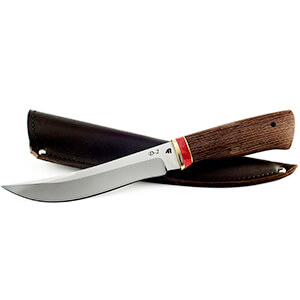
Mainly used for stamping multi-speed cutters. The most resistant to corrosion material, surpassing many other brands in this indicator. The composition of the input chromium, silicon, nickel and manganese in very small quantities.
It has excellent indicators of strength and sharpness of the cutting edge of knives and cutters; all products made from this steel keep the level of sharpening for a long time and do not need regular sharpening.
Also, the products are resistant to deformation even under the influence of very high temperatures, which makes the model ideal in production where cutting and high heat are combined.
Knife composition:
- chromium 11-13%;
- carbon 1.55%;
- molybdenum 0.9%;
- vanadium 0.9%;
- silicon 0.45%;
- manganese 0.35%.
- strength and hardness;
- wear resistance;
- resistance to deformation;
- The level of sharpening of knives is kept for a very long time.
- pitting;
- darkens on contact with acids.
Sandvik 12C27
Steel with a reduced content of impurities and a uniform composition, which allows to minimize defects as in the manufacture
Hardening is carried out with liquid nitrogen, which increases the strength and hardness of the blades while maintaining flexibility and elasticity. The average carbon content makes it possible to achieve good wear resistance, and manganese, together with silicon, improves the overall technical characteristics of the metal.
Alloying elements in the form of vanadium, cobalt and tungsten add toughness and density. The presence of niobium somewhat limits the processing of the metal, but at the same time allows you to get an additional plus to strength.
Knife composition:
- carbon - 0.6%;
- chromium - 13.5%;
- silicon - 0.4%;
- manganese - 0.4%.
- high strength;
- resistance to pitting corrosion;
- long-term sharpening;
- impact strength.
- high price;
- limited processing.
M390
Austrian knife steel has been holding the leading position in terms of popularity and quality for several years in a row, which is due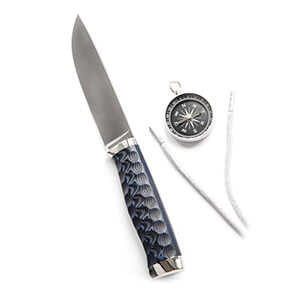
Due to the peculiarities of the chemical composition, steel is quite difficult to heat treat, and proper hardening significantly affects the final result. Uneven processing or insufficient hardening leads to product damage during use and difficulty in sharpening, and overdried material leads to causticity and chipping.
The composition of steel, in addition to iron, includes carbon, a high percentage of chromium, silicon, tungsten, manganese, vanadium and molybdenum.
Knife composition:
- carbon, 1.9%;
- chromium - 19-21%;
- vanadium - 3-4%;
- molybdenum - 1%;
- silicon, 0.8;
- manganese - 0.3%;
- tungsten - 0.5-0.7%.
- can be used in the production of surgical instruments;
- increased strength;
- blade sharpness.
- sharpening difficulty.
Elmax
Powdered stainless steel of Austrian-Swedish production was originally intended for cutting elements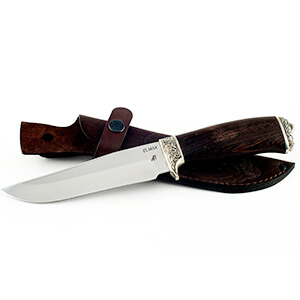
Products are distinguished by high resistance to corrosion, long-term preservation of the cutting edge, ease of sharpening and overall strength. Steel contains chromium, vanadium and molybdenum.
Steel has one of the best indicators of the ratio of cost and quality and in many respects outperforms similar grades in terms of production cost and consumer properties. It holds sharpening angles and grinding well, but is poorly resistant to lateral and shock loads.
It is used in the production of knives of medium and premium classes, while the latter are somewhat overpriced.
Knife composition:
- carbon 1.72%;
- chromium 18%;
- vanadium 3%;
- molybdenum 1%;
- silicon 0.8%;
- manganese 0.3%;
- nickel 0.15%;
- tungsten 0.11%.
- mirror polishing;
- does not corrode;
- maintains the sharpness of the cutting edge for a long time.
- sharpening difficulty.
440C
Chromium steel with a low content of phosphorus and sulfur is resistant to pressure along the rolling axis, so it is often used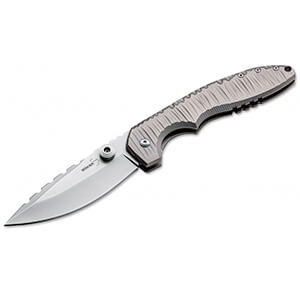
Steel is considered one of the most balanced in terms of composition and cost, but at the same time it is the most expensive in its group of steels. The hardness of steel allows it to be used in the production of not only knife blades, but also in the cutting parts of many conveyors and machine tools.
The high chromium content allows you to get a mirror-like sheen of branded knives. The low prime cost ensures the availability of knives for a wide range of customers.
Knife composition:
- carbon 0.75-1.2%;
- chromium 16-18%;
- molybdenum 1%;
- silicon 1%;
- manganese 1%;
- admixture of phosphorus and sulfur 0.03%.
- availability;
- strength;
- hardness;
- long-term preservation of cutting properties.
- not for work with aggressive environments;
- demanding care.
VG-10
High carbon steel alloyed with cobalt and molybdenum. The viscosity of the material allows hardening to values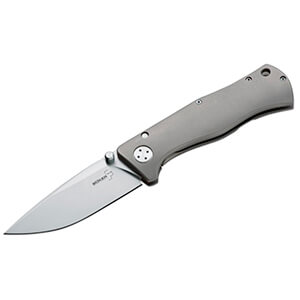
The use of cobalt in the composition of steel, which is rarely used due to its high cost, gives it greater hardness and toughness, so the material is used in the production of premium branded knives, mainly from Japanese manufacturers. Thanks to this, the products are also very resistant to lateral forces and fracture.
The products are characterized by resistance to corrosion - knives rarely rust, are easy to sharpen to the state of a razor, and keep sharpening the main phase of working use for a long time.
Knife composition:
- carbon 1.05%;
- chromium 15.5%;
- vanadium 0.3%;
- molybdenum 1.2%;
- cobalt 1.5%.
- keeps the cutting edge for a long time;
- high wear resistance;
- resistance to lateral force.
- high price;
- complexity of factory sharpening.
CPM-S30V
American-made martensitic steel with a high content of vanadium and chromium. This has resulted in high performance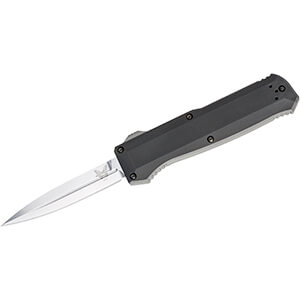
Blades made of this steel are several times more resistant to fracture compared to other models. The cutting edge perfectly resists chipping and crumbling, keeps sharpening for a long time.
It is considered by many experts to be one of the best blade steels available. It is used in the production of both serial and piece models of the middle and premium classes.
The high impact strength and corrosion resistance of steel allows it to be used in the production of survival knives and mushroom picking knives. Also, the cutting edge of the steel lends itself perfectly to editing if necessary.
Knife composition:
- carbon 1.45%;
- chromium 14%;
- vanadium 4.0%;
- molybdenum - 2.0%.
- retains sharpness for a long time;
- resistance to lateral force;
- resistance to chipping;
- easy to sharpen and edit.
- high cost of knives.
AUS-8A
Corrosion resistant steel made by Japanese manufacturer with high content of chromium and molybdenum. Is one of the most widely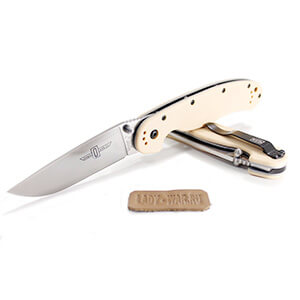
Knives made of this steel do not require frequent sharpening, and you can edit them with most abrasives and even improvised means. The addition of chromium and nickel allows the blades to be polished to a mirror finish. A small content of sulfur and sulfides reduces the ductility and resistance to side impact of the steel, while increasing the resistance to loads along the rolling axis.
Knife composition:
- carbon 0.7-0.75%;
- chromium 13-14.5%;
- vanadium 0.1-0.26%;
- molybdenum 0.1-0.3%;
- silicon 1.0%;
- manganese 0.5%;
- nickel 0.49%;
- phosphorus 0.04%;
- sulfur 0.3%.
- wear resistance;
- simplicity of production technology;
- easily sharpened with improvised means.
- slightly resistant to pitting corrosion.
95X18
Simple stainless steel of the Russian production. Belongs to the budget segment, martensitic class, has a high
With strict observance of the heat treatment process, it has good strength, wear resistance, resistance to corrosion. Products made of this steel do not tolerate fracture loads. At the same time, the cutting edge retains its sharpness for a long time, it lends itself perfectly to grinding and sharpening. The wear resistance of steel is enhanced by the addition of chromium carbides to the composition, and chromium increases the resistance to pitting corrosion.
Knife composition:
- carbon - 0.95%;
- chromium - 18%;
- nickel - 0.6%;
- silicon, 0.8%;
- manganese - 0.8%;
- copper - 0.3%.
- well sharpened;
- resistant to pitting corrosion;
- low cost.
- at the slightest violation of the processing technology, it loses much in quality.
1.4116
German-made steel is used most often in industries with increased hygienic requirements - food,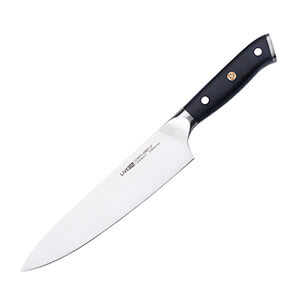
The excellent carbon to chromium ratio provides both high corrosion resistance and edge damage resistance. Knives keep sharpening for a long time and do not darken even when in contact with aggressive detergents, they are slightly oxidized, they keep the working phase of sharpening for a long time, and if necessary, they can be easily dressed with almost any abrasive.
Alloying elements, which are molybdenum and vanadium, increase the strength of the blades and allow them to be sharpened to a smaller angle, which is especially important for kitchen knives.
Knife composition:
- carbon - 0.50%;
- chromium - 14-15%;
- molybdenum - 0.5-0.8%;
- silicon, 0.8%;
- phosphorus - 0.04%;
- sulfur - 0.015%;
- vanadium - 0.1-0.2%.
- availability;
- easy to edit;
- keep sharpening for a long time;
- sharpening at a smaller angle.
- poorly resistant to lateral impact.
What brand to choose?
The choice of steel grade depends on the purpose of the knife.
For a kitchen knife, those brands that are used in the manufacture of surgical instruments are best suited - VG-10, AUS-8 or 40X13. Best for hunting knife steel today it is considered S390, a more budget option - X12MF. For a utility knife, the best choice would be S30V, S35VN or D2 / X12MF.
For those who do not want to devote much time to caring for a knife, it is better to buy 65X13, but it requires frequent editing. If the knife is intended exclusively for cutting, the ZDP-189 is a good and affordable option.
Useful video
What steel to choose for a knife:




